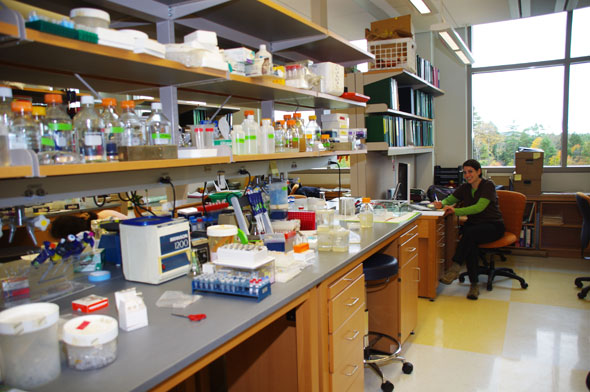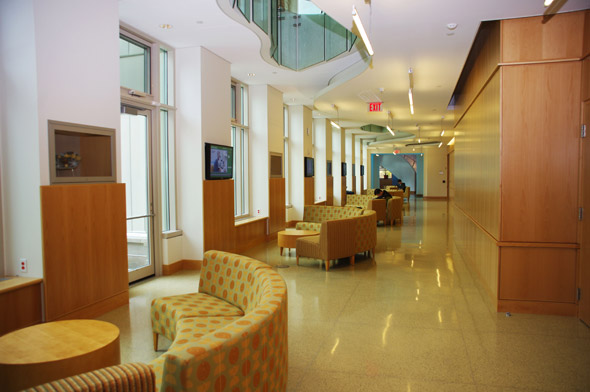
- About
- Departments & Services
- Projects
- Construction in Progress
- Service Requests
- News & Communications
Back to Top Nav
Back to Top Nav
Back to Top Nav
Dedication ceremonies for the new Class of 1978 Life Sciences Center will be held on Saturday, November 5 in the center’s Arvo J. Oopik ’78 Auditorium and are open to the public. Tours of the facility and a reception begin at 9.30 a.m. and the dedication ceremony, led by Dean of the Faculty of Arts and Sciences Michael Mastanduno, will start at 10.30 a.m.

Laboratories in the new Class of 1978 Life Sciences Center are based on an open design to facilitate communication and collaboration among students and researchers. In photo is Alicia "Allie" Sivitz, a research associate in the Department of Biological Sciences. (photo by Joseph Blumberg)
A substantial gift from the Class of 1978 made the construction of the approximately 174,500-square-foot building possible. Chair of the Dartmouth Board of Trustees Stephen Mandel ’78 will represent his class and speak at the event. President Jim Yong Kim, Biological Sciences Chair Thomas Jack, and Provost Carol Folt will join Mastanduno and Mandel in speaking at the celebration.
Located at the northern end of campus, the state-of-the-art structure houses a variety of teaching and research spaces, all designed to facilitate the collaborative approach that characterizes science today.
“At its core it was designed to be a building for modern life sciences that had a flow and a tempo and a flexibility that allowed people to come together in teams, work together, and solve problems of great impact,” says Folt.
Laboratories utilize an open design, without walls between individual work areas. Researchers and students are free to walk about and engage in discussions.

Informal spaces offer opportunities for either quiet study or small group meetings. (photo by Joseph Blumberg)
“Now we're all in a shared common space where everyone is always interacting, and it’s very, very easy to move ideas and techniques between people,” says Mark McPeek, the David T. McLaughlin Distinguished Professor of Biological Sciences.
Mastanduno adds: “The flexible nature of the building’s design encourages our faculty members to be creative and innovative in their teaching and research. Now they can reconfigure learning spaces—labs, classrooms, formal and informal meeting areas—as they pursue new ideas, explore them with their students, and collaborate among their colleagues.”
The building was not only built for science, but with science. The “green” building utilizes innovative design and imaginative execution, resulting in an annual energy cost savings of 30 to 35 percent when compared with buildings of standard construction. Minimal heat loss is achieved through novel insulating approaches and closely monitored air circulation, while storm water is recycled through the plumbing system.
In addition to cohesion with the campus aesthetic, environmental design, and a new breed of collaborative spaces for teaching and research, Architect Natalie Gentile says that a fundamental goal of the design was to simply to create “a place that people would really love to work and learn in.”